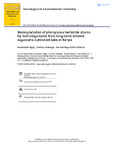Biodegradation of phenylurea herbicide diuron by microorganisms from long-term-treated sugarcane-cultivated soils in Kenya

View/
Date
2011Author
Ngigi, Anastasiah
Getenga, Zachary
Boga, Hamadi
Ndalut, Paul
Metadata
Show full item recordAbstract
The phenylurea herbicide diuron [N-(3,4-dichlorophenyl)-N,N-dimethylurea] is
widely used alone or in a broad range of herbicide formulations. Its degradation
in sugarcane-cultivated soils which have been impacted by the herbicide through
repeated applications was studied. Liquid culture experiments with diuron as
the only carbon source led to the isolation of different bacterial strains capable
of degrading diuron. The bacterial species belonging to the genera Bacillus,
Vagococcus, and Burkholderia, identified through biochemical and molecular
characterization, degraded diuron to different extents. The isolated Bacillus
cereus, Vagococcus fluvialis, Burkholderia ambifaria, and Bacillus spp1 degraded
diuron by 21%, 25%, 22%, and 19% of the initially applied concentration
of 40 mg L1
, respectively, after 35 days of incubation in liquid culture media.
Small amounts of 3,4-dichloroaniline and the de-methylated metabolite N-(3,4-
dichlorophenyl)-N-methylurea were detected in liquid culture media. The
combination of V. fluvialis and B. ambifaria showed an enhanced degradation
of up to 30% of the initially applied concentration of 40 mg L1
. Degradation by
pure isolates was low (18–25%) compared to the capacities of diuron degradation
shown by the bacterial communities (58–74%). This study showed the presence
of diuron degraders in sugarcane-cultivated soils impacted by diuron due to
repeated applications.
